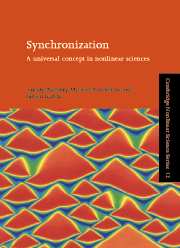Book contents
- Frontmatter
- Contents
- Preface
- Chapter 1 Introduction
- Part I Synchronization without formulae
- Part II Phase locking and frequency entrainment
- Chapter 7 Synchronization of periodic oscillators by periodic external action
- Chapter 8 Mutual synchronization of two interacting periodic oscillators
- Chapter 9 Synchronization in the presence of noise
- Chapter 10 Phase synchronization of chaotic systems
- Chapter 11 Synchronization in oscillatory media
- Chapter 12 Populations of globally coupled oscillators
- Part III Synchronization of chaotic systems
- Appendices
- References
- Index
Chapter 12 - Populations of globally coupled oscillators
Published online by Cambridge University Press: 06 July 2010
- Frontmatter
- Contents
- Preface
- Chapter 1 Introduction
- Part I Synchronization without formulae
- Part II Phase locking and frequency entrainment
- Chapter 7 Synchronization of periodic oscillators by periodic external action
- Chapter 8 Mutual synchronization of two interacting periodic oscillators
- Chapter 9 Synchronization in the presence of noise
- Chapter 10 Phase synchronization of chaotic systems
- Chapter 11 Synchronization in oscillatory media
- Chapter 12 Populations of globally coupled oscillators
- Part III Synchronization of chaotic systems
- Appendices
- References
- Index
Summary
The effect of mutual synchronization of two coupled oscillators, described in Chapter 8, can be generalized to more complex situations. One way to do this was described in Chapter 11, where we considered lattices of oscillators with nearest-neighbor coupling. However, often oscillators do not form a regular lattice, and, moreover, interact not only with neighbors but also with many other oscillators. Studies of three and four oscillators with all-to-all coupling give a rather complex and inexhaustible picture (see, e.g., [Tass and Haken 1996; Tass 1997]). The situation becomes simpler if the interaction is homogeneous, i.e., all the pairs of oscillators are equally coupled. Moreover, if the number of interacting oscillators is very large, one can consider the thermodynamic limit where the number of elements in the ensemble tends to infinity. Now, when the oscillators are not ordered in space, one usually speaks of an ensemble or a population of coupled oscillators. An analogy to statistical mechanics is extensively exploited, so it is not surprising that the synchronization transition appears as a nonequilibrium phase transition in the ensemble.
We start with the description of the Kuramoto transition in a population of phase oscillators. An ensemble of noisy oscillators is then discussed. Different generalizations of these basic models (e.g., populations of chaotic oscillators) are described in Section 12.3.
- Type
- Chapter
- Information
- SynchronizationA Universal Concept in Nonlinear Sciences, pp. 279 - 298Publisher: Cambridge University PressPrint publication year: 2001
- 3
- Cited by

